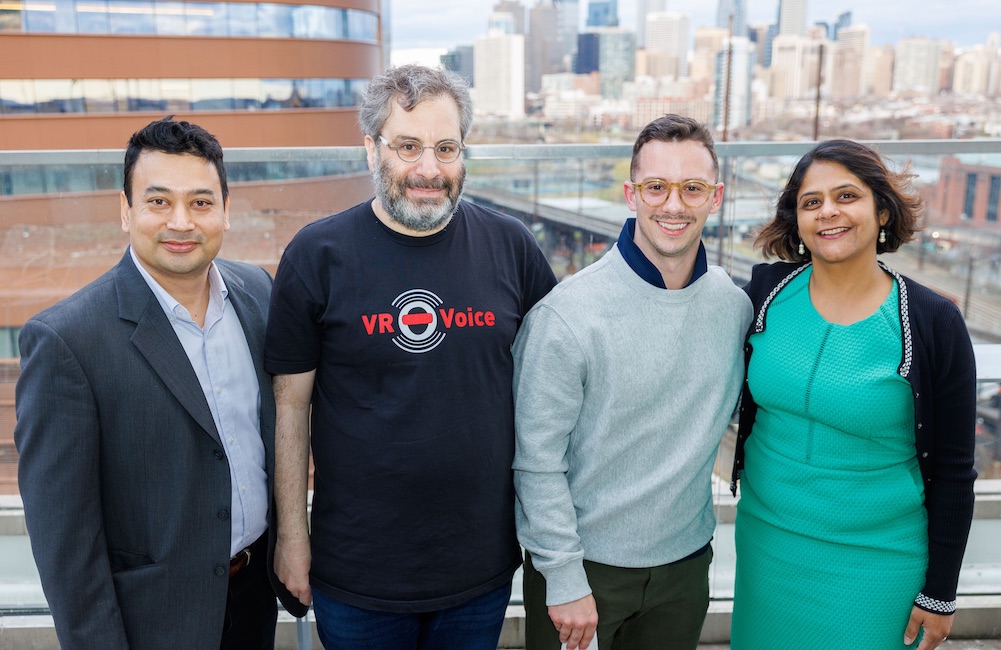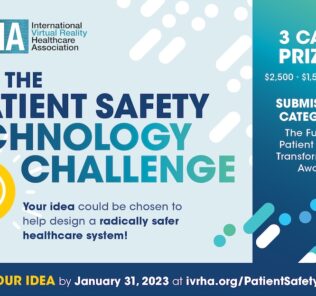IVRHA Patient Safety Technology Challenge Winners Announced
Healthcare simulation competitions are one way for companies and organizations to encourage new ideas across the industry. Recently, the International Virtual Reality Healthcare Association (IVRHA) hosted a Patient Safety Technology Challenge that asked for idea submissions that could help design a radically safer healthcare system. This HealthySimulation.com article shares more about this amazing contest, and the winning ideas and presenters!
Winners
First Prize – $2,500 (WVU team led by Estrada)
Second Prize – $1,500 (WVU team led by Rojas)
Third Prize – $1,000 Kirthika Parmeswaran, Founder of Vital Start
Sponsored Content:
Submission Proposals
FIRST PLACE: “A pilot to incorporate Virtual reality guided breathing exercises for airway clearance in high-risk patients’ post-operative patients: The idea is to create a game in VR as a therapeutic spirometry that implements deep breathing exercises as the main objective. The team hopes this would teach patients good breathing techniques for adequate airway clearance as well as make it fun and interactive for the patients while in the hospital.
SECOND PLACE: The use of virtual reality in the training of physicians in regard to proper and safe techniques when placing central lines: To address the above issues with simulation labs, we plan on using virtual reality in teaching and assisting residents and fellows in appropriate central line placement and appropriate sterile techniques. This would give the trainees the opportunity to practice their skills anywhere and any time of the day. No physical equipment or maikin would be required.
THIRD PLACE: Vital Start offers educational support, access to care, experimental practice, patient engagement, monitoring of the patient, and human-in-the-loop for a one-stop-shop, multilingual support for PMADs across the preconception, pregnancy, birthing, and postpartum continuum. While there are clinical care competitors, most are not focused on the full spectrum of PMADs nor do they have the simulated learning component and many do not have human-in-the-loop or multi-lingual content like our platform. This digital platform provides experiential practice and targeted diagnosis, and psychoeducation and is synergistic with existing approaches to medication management for depression.
Sponsored Content:
Judges for the contest included:
- Dr. Mark Zhang, Medical Director, Innovation Hub, Mass General Brigham
- Dr. Anne Bailey, Director, Clinical Tech Innovation, Veterans Health Administration
- Dr. Brendon Hale, Vice-President of Health and Market Outcomes Research, Penumbra
- Fran Ayalasomayajula, President of Reach
According to Ariana Longley, MPH, Patient Safety Consultant at the Pittsburgh Regional Health Initiative, innovation bolstered by technology such as virtual reality will be critical to rethink how to improve patient safety and reduce medical error, as this remains a leading cause of death in the United States. She explains that investing in technology is an imperative step in safeguarding health at a systems level.
“The Jewish Healthcare Foundation (JHF), a Pittsburgh-based activist and grantmaking foundation, recognized the untenable state of healthcare safety decades ago and continues to honor its commitment to addressing this complex problem,” she explained. “In 1998, it established the Pittsburgh Regional Health Initiative (PRHI), one of the nation’s first regional collaboratives of medical, business, and civic leaders focused on addressing healthcare safety and quality improvements.”
Longley added that, since its inception, PRHI has been passionate about fostering improvements in patient safety. For example, in 2022 it established the Patient Safety Technology Challenge (with funding from JHF) to inspire the next generation to conceive of and create technology-based solutions to the pressing facing today’s healthcare system.
“The Challenge was designed to fuel engagement about patient safety in young innovators by injecting awards into existing competitions and events across the nation,” said Longley. “The Patient Safety Technology Challenge is committed to engaging innovation across the spectrum of creation through two types of awards.”
More About IVRHA Awards
PRHI provided a grant to the IVRHA to integrate patient safety into a Challenge that engages their network as well. Longley explains that this partnership was a natural fit because of IVRHA’s commitment to demonstrating virtual reality’s healthcare applications that can result in improved detection, diagnosis, and treatment.
Grants have been given to inject patient safety into hackathons, pitch competitions, business plan competitions, and accelerator-based competitions across the U.S., from MIT and Stanford hackathons to the Penn Nursing Innovation Accelerator and South by Southwest.
Jump Simulation and OSF Healthcare will be running a Patient Safety Tech Trailblazer in the second half of 2023 that will engage medical learners, residents, and interns in coming up with a tech-enabled patient safety solution. The winning idea will get funding to refine their idea as well as an opportunity to publish and scale the pilot across the 15-hospital system.
“Another goal of the Patient Safety Technology Challenge is raising visibility that the problem of preventable medical error poses. A documentary is being produced to highlight the inventive ideas encountered throughout the funded competitions and demonstrate the need for technology-based solutions,” shared Longley. “HealthySimulation is an inaugural partner of the Patient Safety Technology Challenge that shares invaluable knowledge about technology applications to health care.”
Recorded IVRHA HealthySimulation.com Webinar: Presenting the International Virtual Reality and Healthcare Association
Presented by Robert Fine, ABD, MS, this one-hour, beginner webinar provides an overview of the International Virtual Reality and Healthcare Association (IVRHA), its mission, members, research, resources, and more. According to Fine, decades of research show that virtual and augmented reality (VR/AR) technologies can address the most difficult problems in healthcare. Ranging from mood disorders such as anxiety and depression to post-traumatic stress disorder (PTSD), addiction, autism, cognitive aging, as well as neuro and physical rehabilitation.
He shares that VR/AR technology will continue to have an impact by enabling objective clinical assessments as well as providing for improved skill training and procedure planning. Personal health and wellness can also be improved by using immersive systems to promote better nutrition, engender healthier lifestyles and reduce personal stress and anxiety. Further, as the cost of healthcare rises, VR and AR can serve as effective telemedicine platforms to reduce the costs of care delivery and improve clinical efficiency in both urban and rural settings. Knowing this, the learning objectives of this webinar include to:
- Learn about the mission and vision of the IVRHA.
- Consider how Virtual Reality innovations will improve healthcare education and training.
- Review the latest research associated with virtual reality in medicine and healthcare.
More About IVRHA
On a mission to facilitate and support the growth of the virtual reality healthcare industry, the International Virtual Reality Healthcare Association (IVRHA) is comprised of members throughout the healthcare ecosystem. This includes professionals at technology companies, who teach at hospitals and universities, as well as healthcare providers and insurance companies. Together, these members support the progression of virtual reality in medicine in a way that promotes increased use across the field.
Through this support, IVRHA hosts several industry-related events throughout the year. One of these events is the Inaugural Virtual Reality and Healthcare Technology Transfer Conference. IVRHA explains that researchers at universities nationwide are building virtual and extended reality (VR/XR) applications for use in healthcare — to better detect, diagnose, and treat medical conditions and improve quality of life. The organization hosts this two-day conference for both inventors behind cutting-edge healthcare research, and the outside companies and partners with interests in the field.
The other event hosted by IVRHA is the Annual Virtual Reality and Healthcare Europe Symposium. This conference has a strong focus on providing unique content and perspectives from across the healthcare spectrum. The event also focuses on providing new emerging voices from across the ecosystem: care, technology, research, and policy.
More About Virtual Reality in Medicine
Virtual Reality in Medicine is a three-dimensional teaching tool used across the field of healthcare as a means of both education and instruction. Virtual reality commonly refers to healthcare simulation environments in which learners can experience visual stimuli delivered via computer graphics and other sensory experiences. This advancing technology allows learners to obtain the knowledge and understanding necessary to perform a number of tasks and procedures involving the human body without ever having to practice on a live patient.
Central to this technology is the immersive capacity of virtual reality, meaning that the simulated environment surrounds a learner’s perceptual field. This means that the user feels psychologically present in the digital world, rather than in their physical reality. Used to educate learners on diagnosis, treatment, rehabilitation, surgery, counseling techniques, and more, Virtual Reality in Medicine is helping to train the next generation of healthcare professionals.
This medical simulation technology has shown to have a number of benefits, such as allowing learners to practice their skills without fear of error causing potentially life-threatening impacts.
The virtual reality tools still provide the hands-on experience required to acquire familiarity and comfort in performing procedures, but in a safe and controlled setting. Therefore, as learners make mistakes, they can be thoroughly corrected in real time and without risk. As virtual reality modules still require interaction, skills can become second nature before they are applied in real-world scenarios.
For example, virtual reality in medicine can be used for paramedic training by having learners interact with simulated emergencies where they are faced with high-pressure situations. By learning to respond accordingly, they will be better equipped to handle similar occurrences once they are in the field.
Learn More About the IVRHA Safety Technology Challenge
Lance Baily, BA, EMT-B, is the Founder & CEO of HealthySimulation.com, which he started while serving as the Director of the Nevada System of Higher Education’s Clinical Simulation Center of Las Vegas back in 2010. Lance is also the Founder and acting Advisor to the Board of SimGHOSTS.org, the world’s only non-profit organization dedicated to supporting professionals operating healthcare simulation technologies. His co-edited Book: “Comprehensive Healthcare Simulation: Operations, Technology, and Innovative Practice” is cited as a key source for professional certification in the industry. Lance’s background also includes serving as a Simulation Technology Specialist for the LA Community College District, EMS fire fighting, Hollywood movie production, rescue diving, and global travel. He and his wife Abigail Baily, PhD live in Las Vegas, Nevada with their two amazing daughters.
Sponsored Content:



















